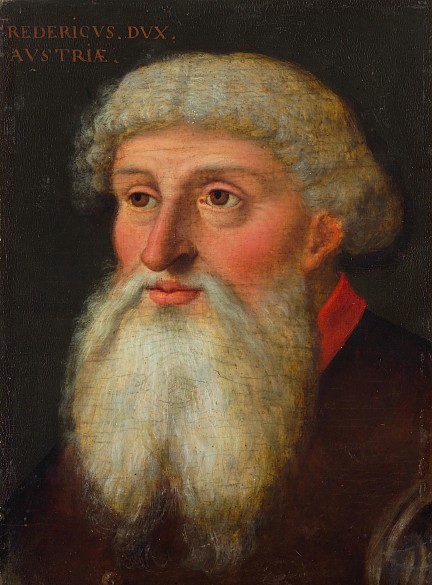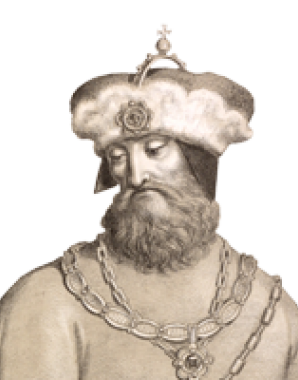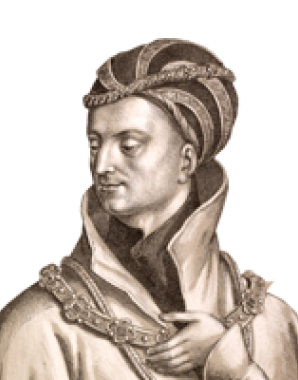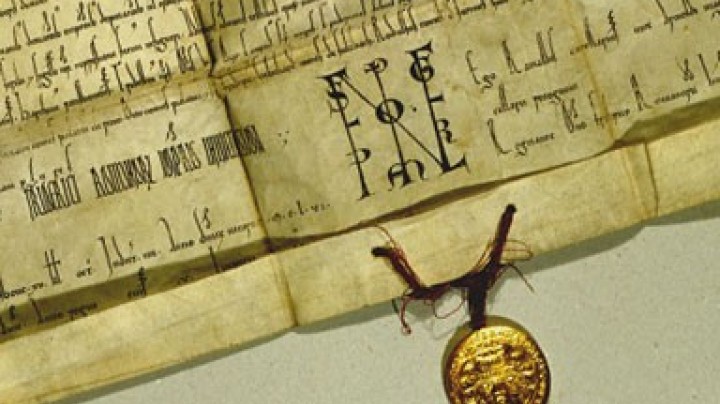Frederick IV of Tyrol
At the beginning of the fifteenth century the Habsburgs wielded only a moderate degree of power in the Empire, ruling over Austria, Styria and Carniola as well as their ancestral lands in Switzerland and Swabia (the so-called Forelands). The dynasty had divided into several lines, and there was strong intrafamilial rivalry.
Frederick was the fourth and youngest son of Duke Leopold III and his Italian wife Viridis Visconti. His father was the founder of the sovereign Leopoldine branch of the Habsburgs. The territories assigned to him included Styria, Carinthia and Carniola (later referred to as Inner Austria) as well as the ancestral Habsburg lands in Swabia and the Allgäu (later known as the Forelands). He was also given dominion over the County of Tyrol, which had only recently come into Habsburg possession.
The acquisition of Tyrol in 1363 put the Habsburgs in possession of an area of enormous strategic importance in the Alps. They then set about attempting to create a coherent territory reaching via Tyrol from their western ancestral lands to the Austrian and Styrian domains in the east. They also aimed to strengthen their position in the Alpine region by uniting dynasties. Thus it was that Frederick's mother, Viridis, was descended from the Visconti family who ruled over Milan and Lombardy.
As part of the separation of the Habsburg family lines, Frederick was promised rulership over Tyrol and the Forelands; at first sharing power with his brother Leopold IV, but from 1406 becoming sole ruler, whereupon he found himself confronted with many sources of conflict.
His reign was characterised by conflict with the Confederates, since a growing number of regions chose to join the newly emerging Switzerland, thereby threatening the traditional supremacy of the Habsburg dynasty in that area. Frederick's father, Leopold III, fell in the Battle of Sempach in 1386, when the Habsburgs' army of knights suffered a crushing defeat at the hands of the peasant army of the Swiss.
Another common opponent was the Venetian Republic, which was a major power in Europe during the Late Middle Ages, and which competed with the Habsburgs for supremacy in "Welschtirol" (Trentino) and Friuli. Danger also threatened from Bavaria, with the Wittelsbachs staking claims to areas of northern Tyrol.
In addition to his extraterritorial problems Frederick also had to contend with internal difficulties: opposition among the aristocracy was forming under the leadership of the influential Tyrolean noble Heinrich von Rottenburg.
The situation was intensified by the personal enmity that existed between Frederick and Sigismund of Luxembourg, ruler over the Holy Roman Empire. The crisis was brought to a climax when the Habsburg ruler and Sigismund quarrelled at the Council of Constance in 1415. The Council had been called in order to bring an end to the papal schism (papal authority was at an all-time low, with three popes reigning at the same time!). Frederick set himself on a course of confrontation with Sigismund, supporting Pope John XXIII, the candidate opposed by Sigismund. However, the latter carried the day, declared Frederick an outlaw (releasing all his feudal lords and followers from their oath of allegiance) and took him prisoner. Frederick was forced to submit and to pay large sums in punitive damages.














